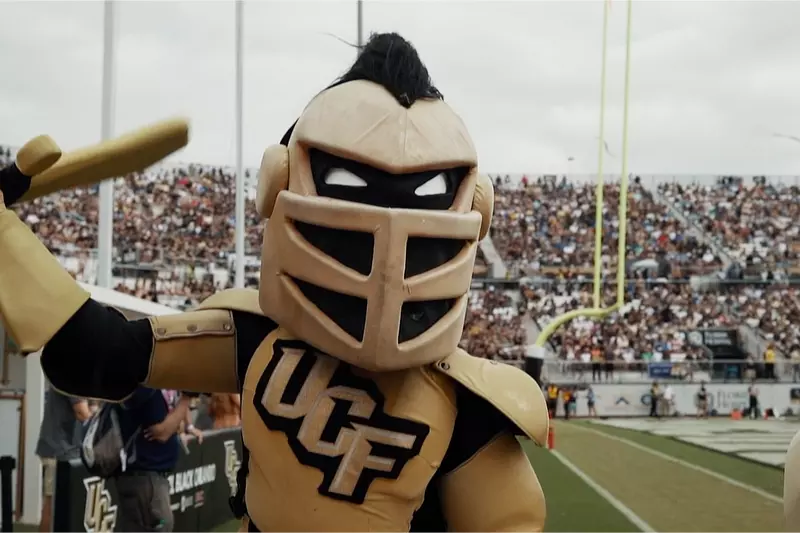- AdventHealth

For all its excitement and exhilarating fandom, American football causes one serious injury: concussion. The complexity of the human brain has brought the diagnosis, treatment and clinical study of this injury into the national spotlight.
No other sport has captured modern American culture in quite the same way as football. Attend one UCF Knights game at The Bounce House and you’ll feel the excitement, literally. It’s almost as if the exuberance of the lively UCF crowd causes an East Orlando earthquake.
But, if there’s a flag on the play and a Knight is hurt, this excitement can turn to concern about injuries like concussions. As modern medicine has advanced, health care experts are better equipped to understand some of the dangers that come with tackle football.
Concussion Education Should Start Early
AdventHealth is at the forefront of the leading-edge science used to understand the ever-evolving relationship between football and brain injury.
Michael Dougherty, ATC, is a Certified Athletic Trainer and part of the AdventHealth Sports Concussion Program. He works with 27 local Central Florida high schools to educate coaches, trainers and parents about sports concussions.
Through a combination of meetings, clinics, on-field guidance and seminars, Dougherty helps put the adults in charge of these young athletes in the best possible position to identify head injuries. Together, they’ve established a baseline concussion protocol for local student-athletes.
What Is a Concussion?
Part of the problem is the ambiguity surrounding concussion diagnosis. You can’t always tell if someone’s had a concussion, as there’s no visible blood, swelling or bruising. Dougherty says a concussion is, “a disruption of the chemicals and electrical signals in the brain.”
This disruption is caused by the brain being jostled out of place and bumping against the skull. Adding to the difficulty is the fact that a person can have a concussion without an obvious blow to the head. These whiplash-like head injuries can be difficult to identify.
Spotting a Concussion
Identifying a concussion is the first hurdle to helping someone who’s hurt. Gone are the days of a UCF Knight wobbling woozy to the sideline, only to go back into the game without a thorough evaluation. Today, head injuries are rightfully taken seriously.
Dougherty says the use of modern tests, such as the Sports Concussion Assessment Tool 5, or SCAT5, has helped identify concussion symptoms on many fronts. Using the SCAT5, trained medical professionals should:
Check for Red Flags
In the case of a suspected concussion, red flags can include:
- Double vision
- Loss of consciousness
- Neck pain or tenderness
- Restlessness or agitation
- Seizures or convulsions
- Severe headache
- Tingling or burning in arms or legs
- Vomiting
- Weakness
Observe the Athlete
Medical professionals can watch the athlete for signs of:
- Blank or empty stares
- Disorientation and confusion when asked basic questions
- Facial or head injury
- Loss of balance and motor incoordination
- Lying motionless
Do a Memory Assessment
If medical professionals suspect a concussion, they should ask the athlete basic questions, such as:
- What is the score?
- Which half of the game is it?
- Which team did you play last week?
- Which venue are we in today?
Do a Physical Examination
Professionals can test:
- Cervical spine health, including neck pain, range of motion, normal limb strength and sensation
- Eye response
- Motor response
- Verbal response (slurred speech)
Dougherty stresses the importance of always comparing any sideline or in-game cognitive evaluation against the players’ baseline evaluation data to ensure accurate results. The baseline tests are done during preseason or training camp. And while tests such as the SCAT5 are a great first step in identifying a potential concussion, they are by no means a final diagnosis. More in-game tests are required.
A sideline neurological exam can check for damage to nerves, as well as a more extensive examination of vision and reflexes. And if any doubt remains, there is the technology offered in the training room where computers can assist with the diagnosis.
The NCAA Rules Are Evolving With Science
In the not-so-distant past, sports highlight shows would feature segments dedicated to the celebration of big wins on the football field. Now, movie stars make major motion pictures about concussion science. As the understanding of head injuries and their impact on long-term health has evolved, so have the rules that regulate the football industry.
The Targeting Rule
The targeting rule (rule 9-1-4) is defined by the National Collegiate Athletic Association (NCAA) as “no player shall target and make forcible contact to the head or neck area of a defenseless opponent with the helmet, forearm, hand, fist, elbow or shoulder. This foul requires that there be at least one indicator of targeting. When in question, it is a foul.”
And the punishments go beyond the 15-yard penalty that penalties receive. Players ruled to have targeted an opponent are ejected from the game, and if the foul occurs in the second half of the game, they are also banned from the first half of their next game.
Coaches from football teams across the Central Florida area — from local high schools to the UCF Knights and beyond — have gone back to the old-school fundamentals of tackling: head up, wrap with the arms and drive with the legs. While these techniques may yield less of the tone-deaf highlight shows of the recent past, they help the sport of football keep up with modern sensibilities.
Equipment Advances and the UCF Knights’ Armor
As concussion prevention and diagnosis efforts improve, so does football equipment to keep UCF Knights safe.
New composite materials have made football helmets lighter and stronger. However, the helmet is no magic armor, according to Dougherty. “The helmet is designed to prevent skull injury and fracture. It can only do so much to prevent the rapid acceleration and deceleration of the head that causes the brain to strike the skull and cause concussions,” he says.
He also worries helmet advancements can make players overconfident in their equipment, believing it can offer them absolute protection.
The broader football culture is coming around to equipment advances, too. Grueling, physical practices are being replaced by contact-free drills and walkthroughs. Dougherty says the increased scientific focus on concussions can make analyzing the effectiveness of the new rules and equipment difficult to gauge.
The new focus on concussions may cause a spike in reported incidents, where in the past they were underreported. So, the data may be skewed until the sample size grows to catch up with modern concussion protocols.
For UCF Knights Fans: Know Where to Go in Case of a Concussion
Tackle football is not the only way UCF Knights players, and their fans, get concussions. Any head injury, no matter how trivial it may seem, can cause the type of brain movement that can lead to a concussion.
To Err on the Side of Caution, Get Care Quickly
Dougherty says to be aware of potential symptoms like nausea, lack of balance and difficulty concentrating. Err on the side of caution, he adds. Go the emergency room if there is any chance you, a loved one or teammate has suffered a head injury.
“A CT scan or MRI will not show a concussion. However, these tests may rule out other injuries,” according to Dougherty. He says the primary concern of ER staff is to rule out brain bleeding, swelling or bruising.
Be forthcoming about all symptoms to your AdventHealth ER staff so that they can better identify an injury that often comes with no physical indicators. Medical professionals will perform the same physical tests on UCF Knights fans as they would on athletes to identify any loss of motor skills or memory.
Another concussion factor to be aware of is a change in sleep. Sleeping more or less than normal could be a sign of a concussion. Emotional changes need to be monitored. It is the lack of overt physical symptoms that requires you be vigilant for these mental cues that a brain injury may have occurred.
And in the case of a concussion diagnosis, rest your brain. As Dougherty puts it, “you can’t put a cast on your brain.” Simple, everyday tasks like reading can cause problems. Excessive exposure to screens, like the television and a smartphone, can stress the brain during its healing process. Even the noise of a busy restaurant should be avoided during concussion recovery.
Where UCF Knights Fans Find Healing From Sports Injuries
Every UCF Knights fan can cheer on their hometown team, knowing the experts at AdventHealth Orlando are looking out for the Knights and the fans, too.
Need help healing from an injury — including a a concussion — or want to get started with physical therapy? At AdventHealth Sports Med and Rehab (a part of AdventHealth Orlando), we’re here to help, so reach out to us today. Also, learn more about how the UCF Knights and AdventHealth partner to make the City Beautiful a better place to live, grow and play.



